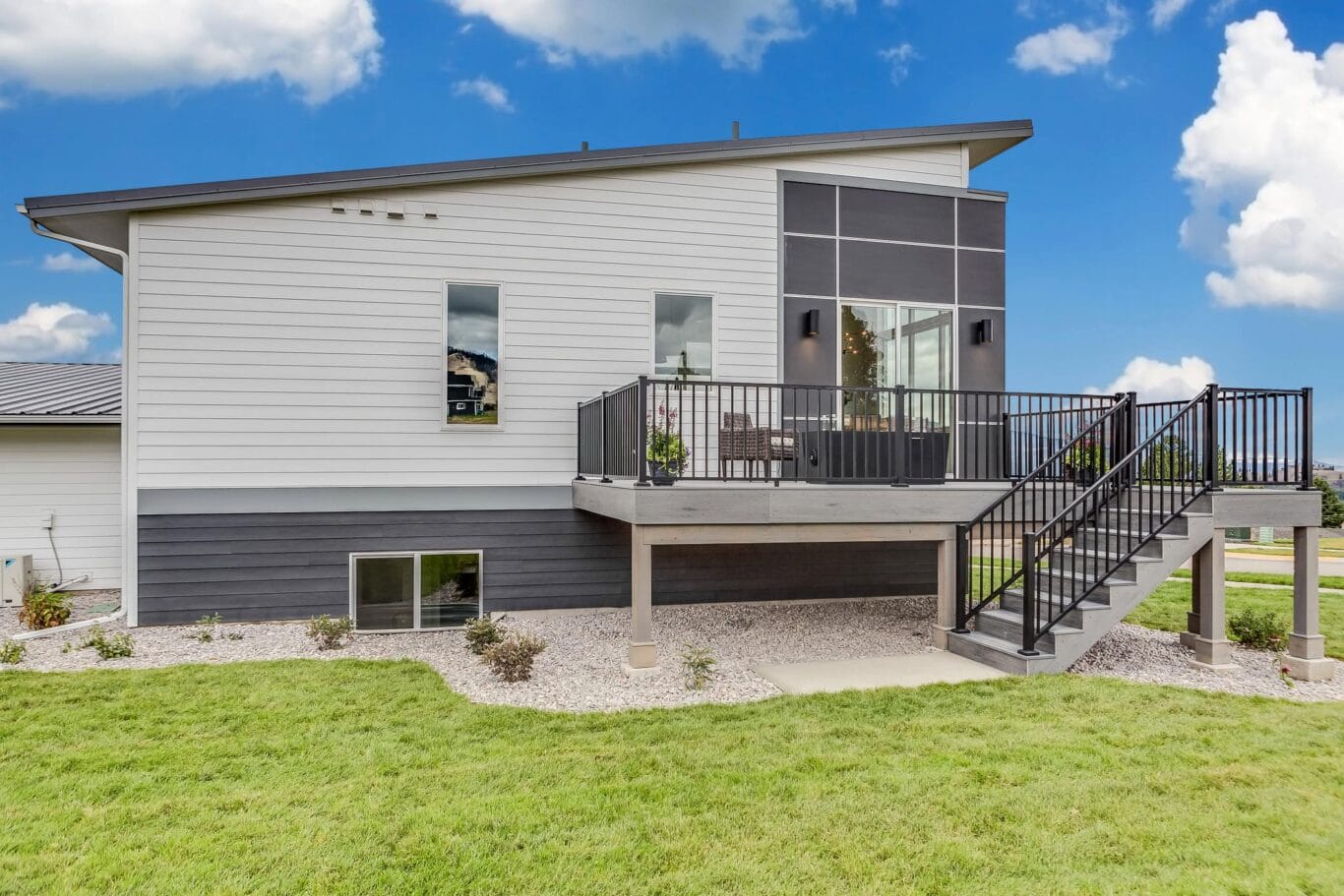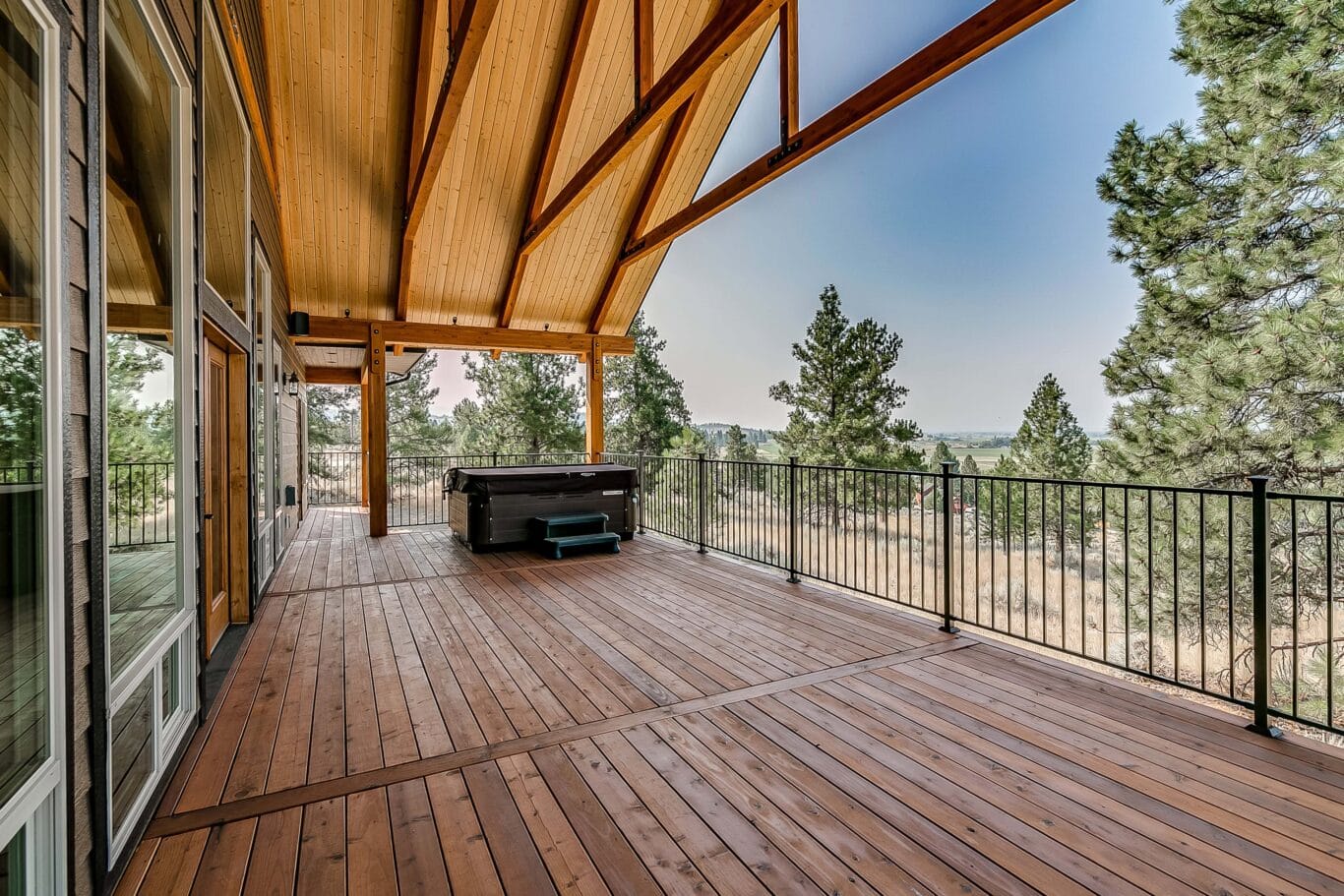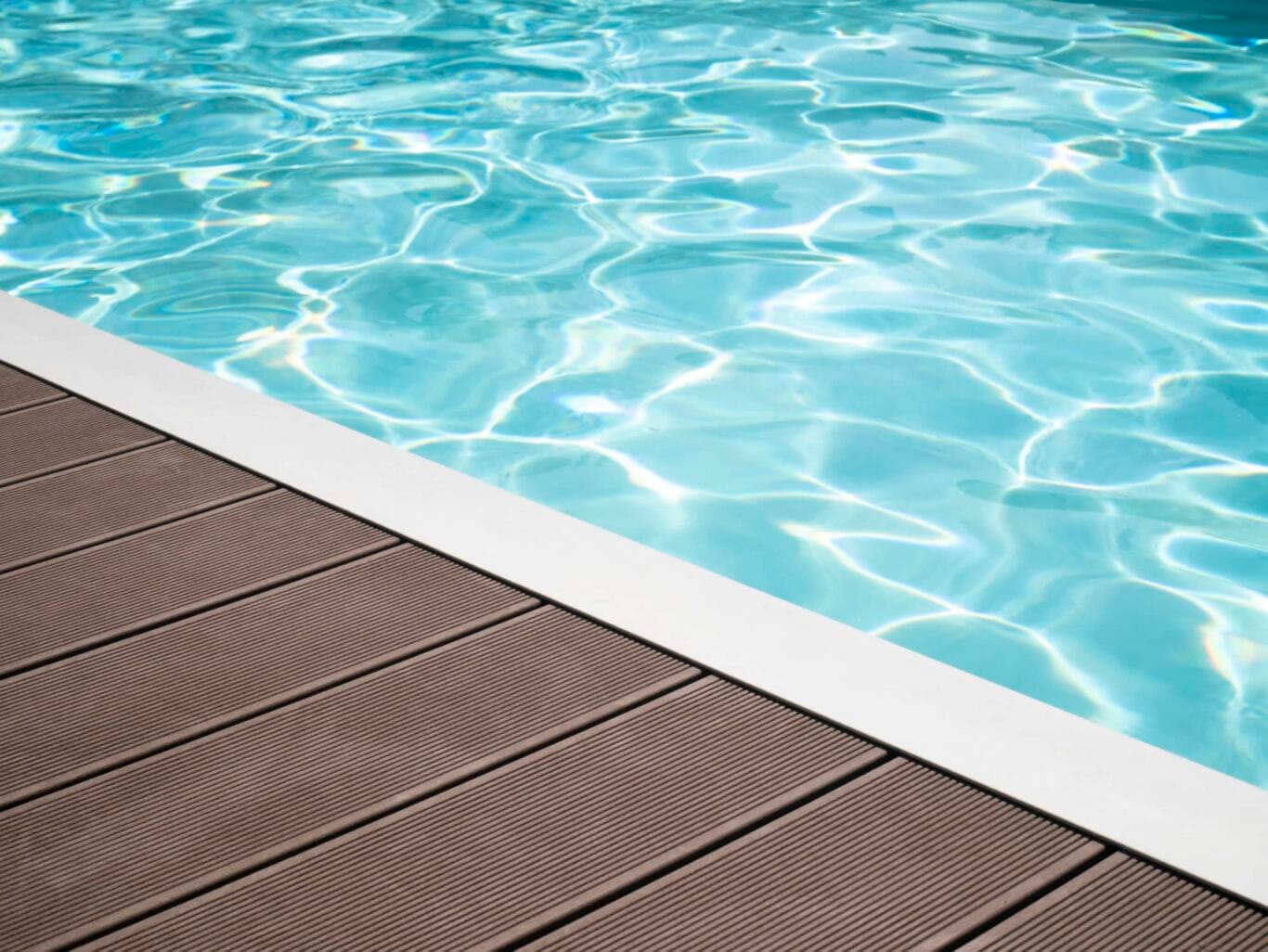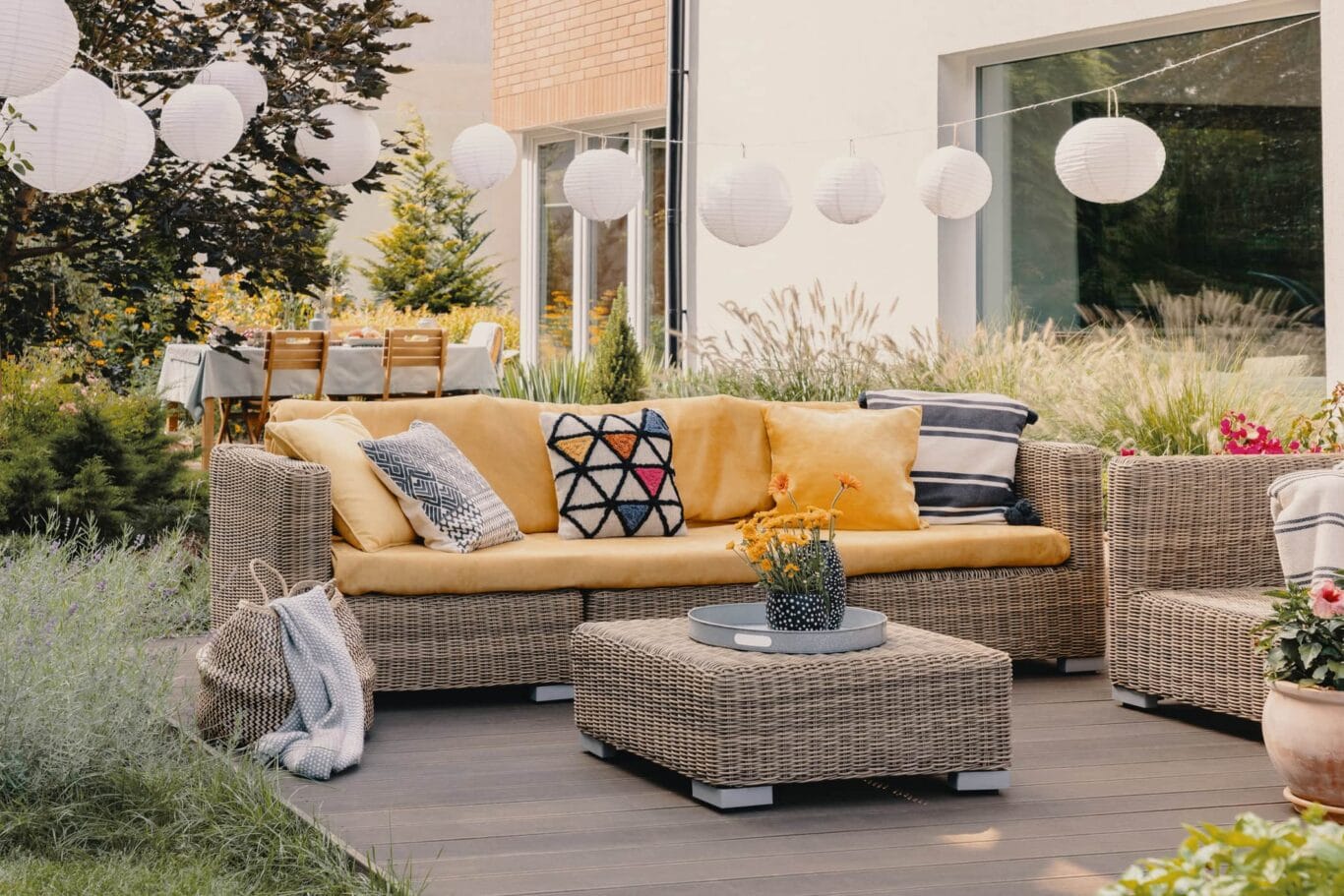Table of Contents
Achieving the ultimate outdoor space for your family is a dream shared by many. However, it is a big project that can feel daunting, especially when it comes to decking. Between designs, materials, permits and all the little details that need to be thought of, it’s easy to feel overwhelmed.
Here’s the ultimate guide to help you create a deck that matches your vision.
What Is the Best Exterior Deck Material?
The truth is, the right decking materials for you might not be the same as for your neighbour. To choose the best exterior deck material, you have to assess several factors: the land, your budget, the aesthetic you are looking for, how long you want your deck to last, the amount of maintenance you are willing to do, the sun exposure of your future deck, who will use it the most, your lifestyle and even your local climate.
Generally speaking, there are three types of material for an exterior deck: concrete, wood, or composite.

Wood is a classic that many Canadians choose. It’s generally an affordable option for a deck, and wood always feels comfortable underfoot, even in the height of summer. However, it’s essential to choose the right type of wood. Some don’t hold up well against the elements and could deteriorate quickly. We have a strong preference for red cedar wood. Since it’s naturally resistant to pests and rot, we consider it the best wood for decks. It’s also incredibly beautiful, with a feel and colour that is truly enticing. Keep in mind that real wood requires regular maintenance, such as cleaning and sealing. When budgeting and planning your deck, be sure to consider this.
Composites occupy a solid part of the market and it’s easy to understand why. Composites are made of recycled plastic and wood, giving you the best of both worlds. The price range is quite extensive, with various qualities and styles, but it’s generally more expensive than other materials. In terms of longevity, it’s practically impossible to beat composite, with some brands guaranteed up to 50 years. Maintenance is minimal; sweep from time to time and wash off stains, if any.
Concrete isn’t typically used for traditional decks. By its nature, you’ll have more of a patio-style outdoor space. Concrete is appealing if your land is flat and you want a more affordable option. Concrete patios are easy to maintain; however, if they crack, repairs will be more of a hassle than with most wood and composite. Stylistically, you have many possibilities. In terms of comfort, concrete can get hot in summer under the sun and will be cold quickly as well. Maintenance is pretty easy.
What Is the Best Composite Decking in Canada?
Choosing the best composite decking in Canada depends on your requirements. Wherever you are in the country, you’ll need a material that can resist intense weather changes and temperatures that can be extreme, which most composites do brilliantly.
All composite decking suppliers offer different products, each with advantages and disadvantages. Though composite is very resistant, lasts decades, and demands little maintenance, there are some differences from one brand to another and from one line to another.

Resistant to moisture: Most composites must be elevated off the ground. However, some companies offer composite lines that are so moisture-resistant they can be used for flowerbeds and even underwater. This is the case for MoistureShield and Azek Products (Timbertech™ Advanced PVC).
Resistant to heat: Not all composites are made for direct sunlight, but some specialize in heat resistance. For decking that stays cool, consider products such as CoolDeck™ by MoistureShield, Deckorators™, and Azek Products (Timbertech™ Advanced PVC). These three options are specifically designed to be comfortable even under the sun in July, making them ideal for families with young children or pets looking for a cool spot outside.
Resistant to fire: Composite won’t usually burn as quickly as wood, but for people living in a zone at risk of wildfire, a deck that is fully resistant can make a huge difference. Both lines offered by Azek Products (Timbertech™ Advanced PVC) comply with Class A WUI (Wildland Urban Interface) standards of the American Society for Testing and Materials (ASTM) and were tested for their frame retardant capacities.
Style and colours: The choice ultimately comes down to personal preference, and you’ll find different colours and textures from various suppliers. Colour should never be the primary factor in choosing composite, compared to other important aspects, but it can be the tipping point between two similar lines.
Resistant to wear: We can’t repeat it enough – composite is extremely resistant. However, some users might want extra durability. For example, if you tend to move your deck furniture around or like to do manual work on your deck, you might want to choose products such as Vision™ by MoistureShield, Voyage by Deckorators™, Reserve by TimberTech™ or Transcend™ by Trex™.
Who Are the Best Composite Decking Suppliers?
When looking for the best composite suppliers, you’ll want to choose brands with a solid reputation that offer a warranty. You might find new suppliers online offering record-breaking low prices, but you’d risk ending up with a low-quality product that won’t last as long.
Our favourite suppliers for the Canadian market are Deckorators™, MoistureShield, Trex™, TimberTech™, Azek Products (Timbertech™ Advanced PVC) and Fiberwood, the latter of which is fabricated in Quebec. All these brands are trustworthy and offer quality products. However, it’s crucial to carefully choose the right composite according to your needs. Even the best composite decking might not be suitable for your deck and not the ideal option.
Ultimately, these are all top-rated composite decking brands, but to choose one, you’ll have to consider the characteristics they offer and their price range. If you wish to dig further, you can research their quality control protocols, environmental policies, customer support reputation, warranties, and availability of products. This will allow you to choose a product that meets your requirements and respects your values as a customer.
Does a Deck or Patio Add More Value?

The question of home value and adding a deck or a patio often arises. Do decks add value to a home? Does a patio add value too? Both options, when well made, can add value to your home. After all, an inviting outdoor space is always a selling point for buyers. Generally speaking, a deck will add more value, especially if constructed with high-quality and resistant material, such as composite. If it’s an elevated deck that offers a better view than ground level, you will likely obtain a return on the investment.
Your local real estate market also plays a role. If decks or patios are uncommon in your area, having one can make your home stand out. Checking nearby properties or consulting a real estate agent can help you decide if adding a deck will boost your home’s value.
In the end, unless you are looking to sell your home soon, focus on your needs instead of those of a potential buyer. This will allow you to create an outdoor space you will enjoy for years. Choose the material and the design while focusing on a long-term perspective. Also, keep your deck or patio well maintained to maximize your return on the investment once you are ready to sell.
Is Composite Wood Better Than Real Wood?
There are some notable differences between composite and wood. Composite is more resistant and requires much less maintenance than wood. However, composite is more costly. Depending on which composite it is compared to, wood will be more comfortable in the heat. The natural aspect of wood is non-negotiable for some people. Which one is better? It all depends on your needs, preferences, and your budget.
If you are looking for a less expensive alternative that doesn’t have to last decades and don’t mind doing maintenance, a wood deck could be for you. It’s important to know that some woods, when well maintained, will still last for a long time.
If you are thinking long-term and prefer a maintenance-free option, you should seriously consider composite. If you have specific requirements for your deck, such as resistance to fire or high humidity, some composite brands will offer exactly what you need.
In terms of look and design, it’s a matter of taste. Wood has a look and smell that can’t be perfectly reproduced. However, composite offers you a wide variety of colours and textures to choose from, which you’ll never need to sand, seal, or repaint.
Whether you choose a wood or composite deck, take the time to assess your needs and choose the right material for your project and your budget. Not all woods are suitable for a deck and not all composites are created equal. A poorly made composite might cause more problems than natural wood.
What Type of Wood Is Best for Outdoor Decks?
The structure is often made of pressure-treated wood, sometimes steel beams, or other materials. The decking floorboards can be made of natural wood or composite.
If you love wood’s natural appeal and choose it for your deck, there are a few things to know. First, not all wood is suitable for a deck. Many softwoods are easily damaged by the elements. In Canada, two types of wood are usually used for decking: pressure-treated wood and cedar.
Cedar is our preference, especially red cedar from the West Coast. It’s often the recommended wood for decks. Cedar is naturally resistant to water, fungi and pests thanks to its preservative oils. Compared to other types of timber, it’s resistant to cracking, splitting and warping, making it the perfect decking for walking barefoot during summer. Like any wood, cedar requires some maintenance, but it will last for decades if done correctly. Since it doesn’t contain resin, it’s easy to work with and can be used with different finishes. Depending on how it’s sourced, it can be an environmentally friendly option.

Pressure-treated wood is the cheapest option. It is resistant to mould and insects. Since the material itself is inexpensive, doing repairs, such as changing a board, isn’t a big deal in terms of budget. This is why it’s often used for structures. The main problem is that it will decay over time, eventually fade in the sun, and can splinter or crack due to drying. Pressure-treated wood will require maintenance, which can become costly over time.
Redwood is popular on the West Coast and especially in the United States. It’s an excellent wood with a beautiful red hue, but it remains expensive for the Quebec market and is rarely available due to transportation costs.
You might be wondering just how long do wood decks last, as it’s often said that wood doesn’t last as long as composite wood. Longevity varies greatly according to the type of wood, regular maintenance, and external conditions. With proper maintenance and ideal conditions, wood decks can last up to several decades.
How to Save Money When Building a Deck
Building a deck can be a significant investment, depending on several factors. Four main criteria will define the total cost of your deck: size, the complexity of design, material choice and labour costs in your area.
Size: It’s simple logic; the bigger the project, the more material to buy and the longer it will take to build… and the more expensive it will be. To save money, assess the size you really need and, if possible, go smaller.
Design: Cutting and detailed work takes more time. Decks with irregular shapes require more material for the same surface, and you will end up with some waste. Keeping a straightforward design will save you money.
In terms of design, consider the height of the deck. Many materials can’t sit directly on soil (some can) but this doesn’t mean you need a high terrasse design. A deck just above ground allows for a simple design, with a few or no stairs and no rails.
Material choice: Wood, even high-quality red cedar, is more affordable than most composite and PVC. For the initial cost, composite will be more expensive, but it will last longer. There are ways to slightly reduce the cost with tips, such as building the underskirt in cedar or pressure-treated wood, instead of composite. You’ll benefit from your composite of choice while cutting the cost to a certain extent.
When it comes to material choice, don’t forget the railing and stairs. These two elements can be a way to save money by choosing more affordable materials or simpler designs. If your deck is elevated, it will possibly require railings and stairs. For railings, you’ll find prices that vary, with options like natural wood, different composites, and glass and aluminum railings. For stairs, you will also find different price ranges, from simple premade stairs to custom-made ones.
Even lighting comes into play when planning for the cost of your deck. As long as the safety aspect is respected, you can save money by choosing less costly options. The initial lighting could be simple to avoid extra costs. In the next year, you could add more lights to create a more sophisticated vibe.
Cost of labour: The cost of labour can vary greatly from one region to another, so make sure to calculate this in your budget.
You can save money by doing part of the work yourself but consider the value of your time. If a project takes several weeks, doing it yourself might not be worth it.
Another idea is to work with experts, which may be the most cost-effective option, helping you to save both time and money.
Consider the time of the year and how busy contractors are. Early in the season, when they have fewer projects, you might be able to get a better deal. Plus, you’ll have more time to enjoy your deck for the summer. Fall can also be a good time to build, as long as your project is finished before winter sets in.
Overall, if you wish to save money, you’ll have to compromise somewhere. For example, if you absolutely want a large deck, you could choose cedar instead of composite. If you want composite and cannot reduce its size, you can choose a simpler design. We can’t take away the importance of the initial cost. However, longevity and maintenance costs should be taken into account. Sometimes, a more expensive project, over decades, will become the wisest course. Also, don’t forget that a well-built deck will add value to your home.
What Is the Best Timber for Pool Decking?
A pool deck has very particular requirements. It has to be safe, comfortable, and ideally beautiful. Most people want to spend a lot of time on their deck, and a pleasing appearance is always a plus.

In short, you’ll want to think of these characteristics:
- Resistant to water and humidity: Since a pool deck is often wet, it should not be made from a material that will quickly degrade or form mould and mildew.
- Resistant to heat: People will most likely be barefoot around the pool and don’t want to walk on a hot surface.
- Slip resistant: We know how slippery a wet surface can be, and falls can happen quickly with potentially serious consequences. This aspect is fundamental for your safety and that of your loved ones.
- Looks: Compared to safety, looks shouldn’t prevail, but a pleasing appearance will enhance your outdoor experience.
- Budget: Material and design can be costly, so knowing your budget is key.
For natural materials, western red cedar is an excellent choice for a pool deck. This wood is particularly long-lasting and is naturally resistant to rot, mould and fungi. Cedar can be constantly splashed with water without forming mildew. With proper sealing, cedar won’t become too slippery when wet. If you choose a dark sealant, the wood could become hot in the sun but generally cooler than most composites. As with all wood, maintenance will be needed, especially when installed next to water. Sealing cedar wood is essential to enjoy its properties.
Be careful when choosing wood for your pool deck, as some wood can easily cause splinters, be too slippery or degrade quickly.
Depending on your budget and project, you could consider some composite materials for your deck. Brands like TimberTech™ and MoistureShield offer products that are cool underfoot and resist water. Trex™, a high-quality PVC, is also an interesting option, as it can even be used underwater. Composites can have a texture or a finish that makes them non-slippery, enhancing safety.
Your Dream Deck is Within Reach
Building a deck can enhance your living space and allow you to enjoy your home to the maximum. The sky is the limit when it comes to design, especially when you add railings, lighting, plants, and other accessories. Whether you want a concrete patio, a wood terrace looking over the view or a functional composite deck with tons of storage, every dream is possible. By trusting experts, you can be sure of having the ultimate result and an outdoor space that fits your needs, all while remaining within budget.
